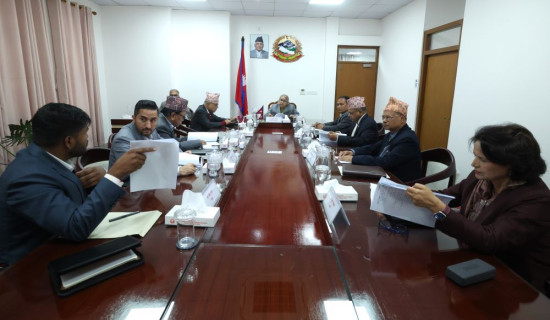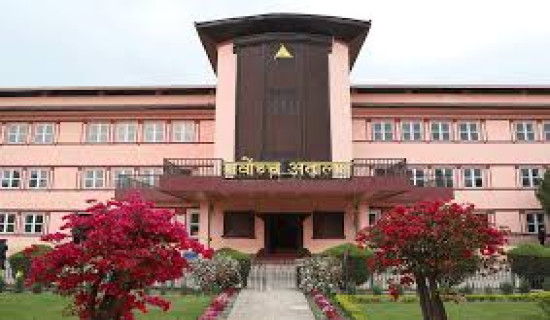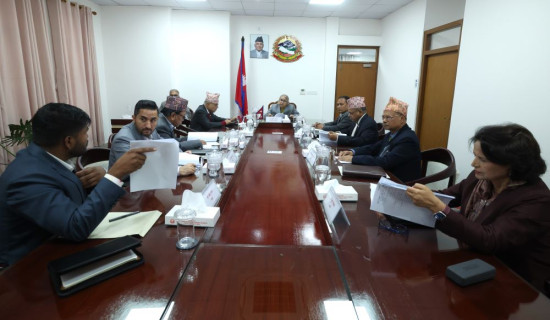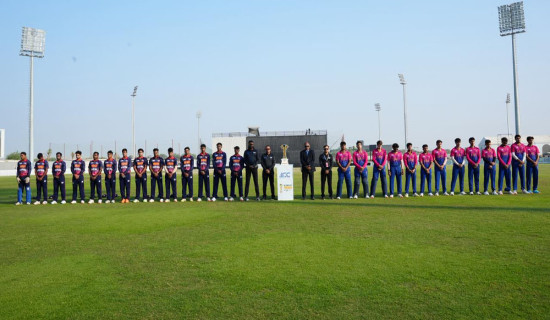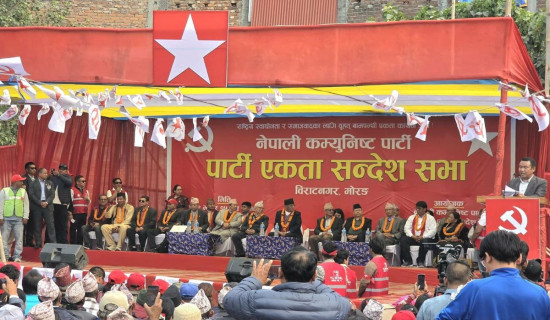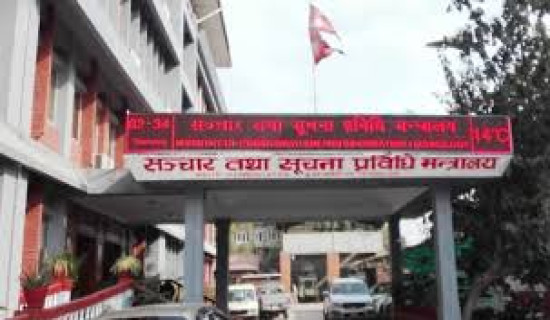- Tuesday, 2 December 2025
Jagadish Nepali’s Micro-Stories
Sita Sapkota recently published 'Jagadish Smriti,' a compilation featuring 30 micro-short stories by Jagadish Nepali. The editor, Mahesh Prasai, exhibits a clear passion for this literary genre. The volume spans 406 pages, offering insightful perspectives on micro-stories and providing an extensive background on the writer. Contemporary peers of the writer have contributed reviews and illustrations, alongside critics from the post-writer years. The volume is divided into two main sections.
The initial, larger section spans 370 pages and includes 63 articles about the writer. These articles shed light on the writer's profile and hint at the future significance of micro-stories. Subsequently, the volume presents the 30 stories that effectively illuminate and archive the writer's literary persona.
Micro-stories are not common in Nepali literature, with only a handful of writers exploring this genre. Interested Nepali readers, instead, tend to engage in the hobby of reading conventional genres such as fiction (both short and long), subjective essays, poetry (epic or short), and plays. 'Jagadish Smriti,' in contrast, successfully carves out micro-stories as a distinctive literary identity. It's no surprise that this genre is gradually gaining academic interest and acknowledgment.
Even before the book's publication, university students studying literature were dedicating dissertation papers to these micro-stories, often earning a perfect score of 100. This trend underscores the book's significance for university colleges and Nepalis abroad (NRNs). Consequently, micro-stories are no longer considered a unique and unconventional form. However, the local book market may not experience significant returns, mainly due to a less prevalent buying culture.
Editing and publishing
Mahesh Prasai’s meticulous editing signals his extra efforts. He must have made special requests to engage learned writers for the review articles. Getting articles from them potentially must have been his prolonged and tireless waiting, not of months but of years. Sita Sapkota’s publishing zeal shows that she is equally dedicated. Both the editor and publisher have close family ties too. They are cousins: Mahesh is the son of the writer’s younger sister, Dharani, and Sita is the wife of the writer’s younger son.
The editor had spent his early days until college with the writer and his family. In that sense, the writer and his family seem to have had a clear literary impact on him. The publisher and editor have one more identity to be unveiled. The writer is the son of Mahanand Sapkota, a renowned linguistic and literary giant in Nepal. The publisher, Sita, was married into this family after her father-in-law’s death. Thus, her enthusiasm to bring forth the book demands true recognition.
The editor and publisher are remotely connected at present. If Sita stays far away in Texas, the editor's cousin Mahesh is in Kathmandu. Their being away across seven seas seems another reason to bring them much closer. In all, ‘Jagadish Smriti' is a homage to their guardian angel and an archive of literary contributions. Their endeavours are a sign to reawaken the writer’s talent. Now the book stands as a historical testament to Nepali literature, particularly in the micro-story genre.
Global trend
Micro-stories are catchy for today’s jet-set globetrotters. Time chasers can easily go through these stories in 2–3 minutes. Its specialty is brevity, which leaves a long-lasting impression. A couple of minutes in it speaks enough of a social phenomenon, a life, or an individual of unnoticed sublime value. Micro-stories, as such, are condensed capsules brimming with an underlying message. Workaholics can thus easily spare time for such mini-vitamin foils.
Contents of a story in English read in less than an hour are short novels termed micro- or flash fiction. Wikipedia defines 100-word-long fiction as drabble, microfiction, or twitterature. In this context, it is logical to appreciate that the Sanskrit folk stories of Panchtantra are micro-stories with morals and motivations. Micro-stories in this context are brief readings that take just a couple of minutes. As time in this IT-driven world relentlessly chases, such story clips play an immense role in everyday life. Consequently, life has to skip both time and reading and, unfortunately, information treasure and recreation.
If we consider examples of English and Hindi micro-stories, we find that they are already established genres. Such concise writing shares similarities with the Japanese haiku. Nepali writers were relatively few in this domain for their readers.
However, they are now catching up with broader international practices. As a result, Nepali literature is making strides in embracing this condensed form. Madhupark, the Nepali monthly magazine, includes such stories in its roster between its pages.
One notable example is the anthology of micro-stories, 'Phool ko Aatank,' by Dhruva Chandra Gautam. The efforts of Madhupark and individual writers contribute to the evolution of micro-writing in the Nepali landscape. In this context, micro-stories by Jagadish Nepali undoubtedly play a pioneering role in establishing the narrative prowess of a storyteller. In a world where time is limited but timeless, he has undeniably earned a prominent place.
The writer
Initially a school teacher, the writer later became known as Jagadish Sir. Educating children was his passion. Once, he invited a woman teacher, Chandra Kala Kiran, to Dharan for a home science program. She later served in the government and retired as a secretary.
He had entrepreneurial zeal, too. Once, he set up a bus transportation company under his leadership, connecting Biratnagar, Kathmandu, and Dharan. Soon, it had come to grand success. Then he proudly exclaimed, 'The company hit like a triple of three aces in the playing card game of flush!' Besides, working for others was another venture. He made frequent trips to Kathmandu and Indian regions to buy Hindi feature movies. In addition to his dignity,
he was wonderful at speaking fluent Hindi, Bengali, and English. His high school education was not complete, though.
Beyond those pursuits, Jagadish had remarkable boldness in politics. In the heyday of King Mahendra, he delivered a speech in the yards of Marwari Sewa Samiti, Kathmandu. He had then sharply criticised both the alleged pretended Panchayat philosophy and the king. His challenge was against the rule, then boldly stating, 'Panchayat is not a philosophy and can never be it; it’s merely King Mahendra’s whim of direct rule.' Whether in his hometown or the capital city, he was an elite figure, personally known by many ministers and VIPs.
With all this, his schedules were hectic in the growing city of Dharan, which was for his growth as well as that of his family and living standards. Upon knowing this, the question is: he had time constraints, hadn’t he? Truly amazing! He hasn't found time to write yet! Still, he stole free moments for the writing.
Exploring further
The present-day marketed book comprises 30 stories by the author. But the question is: didn’t he write anymore? If he did, were they lost? I have here two more-story versions, as told by him, that I could not see in the book. Story One:
Two policemen on evening duty aimed to arrest unruly drinkers to please their seniors. Upon finding no such scene in a local pub, they, hopelessly, ended up drinking themselves, had a brawl between them, and arrested a third person there as a scapegoat for their boss. Story Two: An army pensioner submitted his ID card to the office to draw his pension. Then he stood and waited in the queue.
The wait was prolonged, and he lost his temper. Now, gritting his teeth against the officer, he said, 'Why late? Should I break your tooth?' The calm officer said, 'Let's see who’s to break...'. The next time the pensioner showed his ID, he had to break his own front tooth because the card mentioned, '"One tooth broken.'
Whether these stories were created on short notice or were already written and subsequently lost remains unclear. Nonetheless, these anecdotes offer a glimpse into the writer's storytelling prowess and present intriguing narratives that may have slipped through the sands of time.










